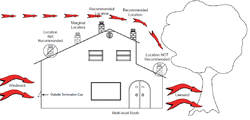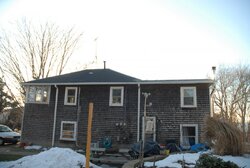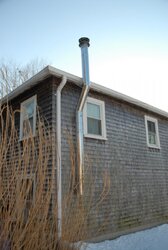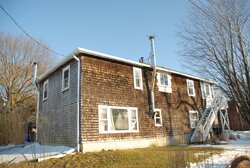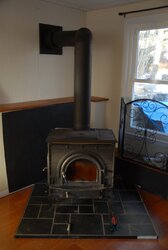Hey all, just looking for advice to see what the hell i did wrong! Friday night during the storm, had my CDW2461 going strong, nice secondaries going (even with my toasted cat), house was at a toasty 77, and then one gust of wind (measured at 66MPH on my WeatherStation) changed all that. Stove started backpuffing, then the puffing turned into a non-stop backdraft. I tried everything my few brain cells could think of to reverse it - Opened windows on one side of the house, then both sides, then the doors. I then tried a fan in the window blowing in (for positive pressure) Everything i tried made it progressively worse, then the power started flickering. Got terrified as the fire got bigger, and the flames started heading for the air inlets. Opening the bypass created a downward fireball.
SOOOOOO, I RAN for the fire extinguishers, opened the firebox door, sprayed it, and NOTHING! 2 Boxes of Baking Soda, Dirt from house plants, and another fire extinguisher barely stopped the flames. Grabbed a 10 gallon metal tub of "standby" water, pulled out the logs, and gave them a bath! Luckily, my father-in law stopped by as this was going on, and helped me out. We both agreed we'd never seen anything like that before.. We were trying to figure out what would cause the "Endless Loop". I didn't have a thermometer handy, but i'm sure the pipe was plenty hot enough, and i'm burning well seasoned Beech, Black Cherry, and White Oak. I tried 5 more times Saturday after the wind died to get it going again, and same thing. On Sunday, I was able to use a portable heater, stuck it right inside the firebox and let the pipe warm up, and all is back to normal, for now. This happened once before in a storm, but I was quickly able to reverse it. I've been a wood burner in one form or another for the last 13 years (except for 2 seasons) and I'm terrified it will happen again, and am thinking about investing in a generator instead of a new stove.
A little info about the install - Ground floor of a "cottage" in our living rm, this part of the house was an addition with a shorter roof. Rest of the living space is 2nd floor. It's a VC/CDW 2461, top exit 2ft of vertical pipe up to a 90deg, then 30" of horizontal pipe to the outside, to another 90, then about 22ft of Duravent (Double Wall, obviously) outside vertical pipe, to the cap. There is a roof vent for a kitchen exhaust fan in the main roof. It's about 6ft higher than the chimney. Could this be creating the negative pressure, and pulling from the stove? The entire house was caked in snow/ice, and any usual air infiltration spots were blocked? A combination of the 2?? I was thinking about an updraft vent cap, or am i way off? I could post pics if that would help. Sorry for the long-winded post, but any pointers may ease my mind!
SOOOOOO, I RAN for the fire extinguishers, opened the firebox door, sprayed it, and NOTHING! 2 Boxes of Baking Soda, Dirt from house plants, and another fire extinguisher barely stopped the flames. Grabbed a 10 gallon metal tub of "standby" water, pulled out the logs, and gave them a bath! Luckily, my father-in law stopped by as this was going on, and helped me out. We both agreed we'd never seen anything like that before.. We were trying to figure out what would cause the "Endless Loop". I didn't have a thermometer handy, but i'm sure the pipe was plenty hot enough, and i'm burning well seasoned Beech, Black Cherry, and White Oak. I tried 5 more times Saturday after the wind died to get it going again, and same thing. On Sunday, I was able to use a portable heater, stuck it right inside the firebox and let the pipe warm up, and all is back to normal, for now. This happened once before in a storm, but I was quickly able to reverse it. I've been a wood burner in one form or another for the last 13 years (except for 2 seasons) and I'm terrified it will happen again, and am thinking about investing in a generator instead of a new stove.
A little info about the install - Ground floor of a "cottage" in our living rm, this part of the house was an addition with a shorter roof. Rest of the living space is 2nd floor. It's a VC/CDW 2461, top exit 2ft of vertical pipe up to a 90deg, then 30" of horizontal pipe to the outside, to another 90, then about 22ft of Duravent (Double Wall, obviously) outside vertical pipe, to the cap. There is a roof vent for a kitchen exhaust fan in the main roof. It's about 6ft higher than the chimney. Could this be creating the negative pressure, and pulling from the stove? The entire house was caked in snow/ice, and any usual air infiltration spots were blocked? A combination of the 2?? I was thinking about an updraft vent cap, or am i way off? I could post pics if that would help. Sorry for the long-winded post, but any pointers may ease my mind!




 As for the other comments, it was inspected and passed no problems. I'm starting a war at home with this, but i'm suspicious of the kitchen exhaust being about 6-8ft higher than the pipe, as i think this is part of the problem... I just got home from a super long day at work. I'll post some pics of the setup tomorrow. For the first night all winter, i'll shamefully admit that i'm too tired to burn anything tonight!
As for the other comments, it was inspected and passed no problems. I'm starting a war at home with this, but i'm suspicious of the kitchen exhaust being about 6-8ft higher than the pipe, as i think this is part of the problem... I just got home from a super long day at work. I'll post some pics of the setup tomorrow. For the first night all winter, i'll shamefully admit that i'm too tired to burn anything tonight! 38
38 outside and 65 inside. i'll be ok!
outside and 65 inside. i'll be ok!